(( Penrose tiles, they often have a pleasing and even mesmerizing quality, and their regularity often exhibits a certain natural harmony((((9彭羅斯瓷磚, 它們通常具有令人愉悅甚至令人著迷Enchanting的品質,它們的規律性通常表現出某種自然和諧,我們大多數人都知道,只有三角形、正方形和六邊形才能用單一類型的正多邊形瓷磚平鋪平面.
。激發您的想像力,所有這些各種圓形和五邊形的基本彭羅斯拼塊都可以以不同方式拉伸,尤其是通過耦合到無窮大。Boost your imagination, all these various circular and pentagonal elementary Penrose tiles can stretch differently, especially by coupling going to infinity.
smallest Pentagon shape and circular Penrose tiles, and their translational periodic configures and correspondent unit cell.
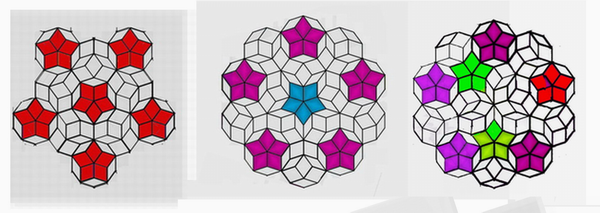
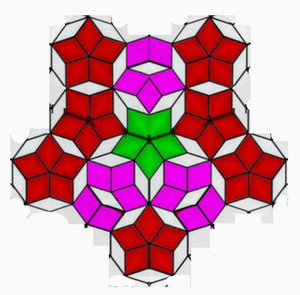
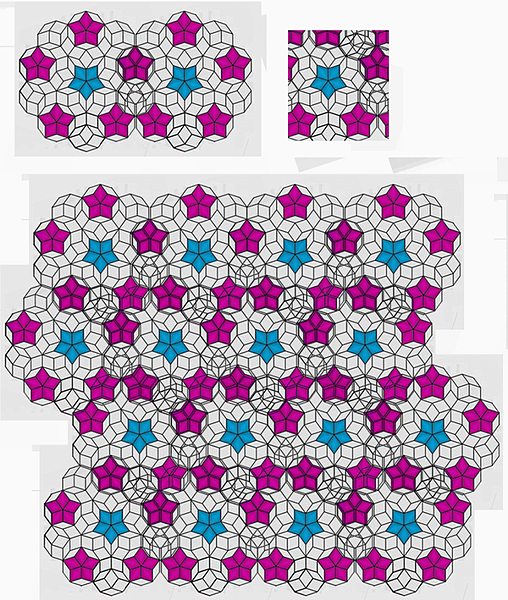
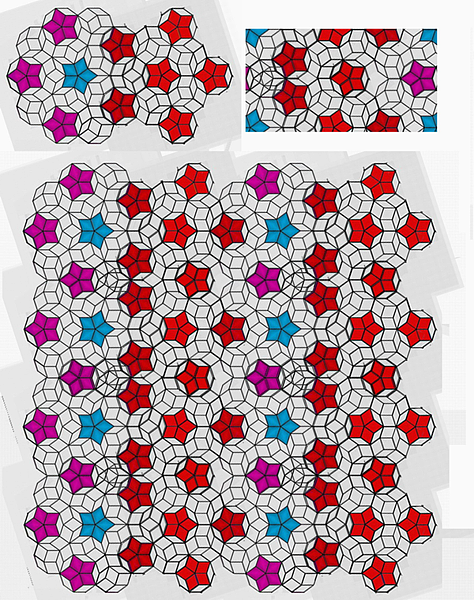
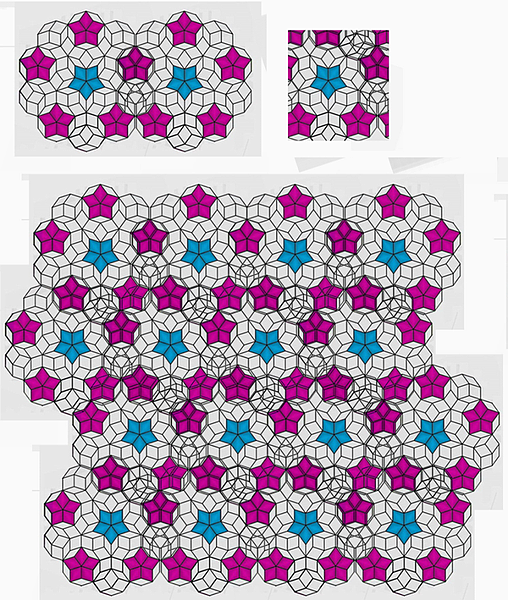
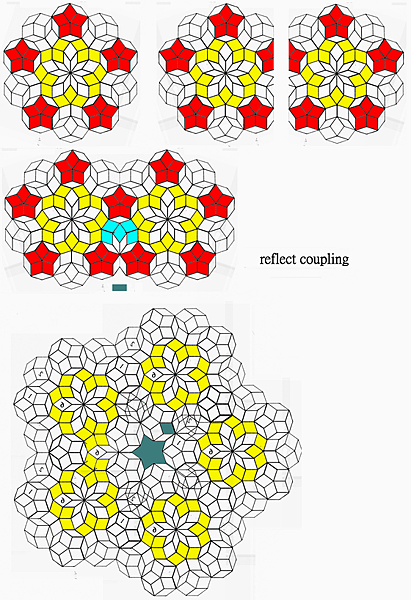
From an artist's point of view, Pentagon (P-) shape and circular (C-) shape penrose tiles, are most easy to understand and see the inside of the structures as well as most beautiful tiles ,,,.,
a coupled procedure that extends tiling by only two types of regular decagons is a most simple and understandable procedure .
從藝術家的角度來看,五邊形 (P-) 形狀和圓形 (C-) 形狀的彭羅斯瓷磚,是最容易理解和看到結構內部的,也是最漂亮的瓷磚,,,僅通過兩種類型的正十邊形擴展平舖的耦合過程是最簡單易懂的過程。。
Pentagon shape and circular shape penrose tiles, and each one hides inside each other and both extends to infinite by a same procedure. 兩種類型的十邊形可以形成簡單易懂的五邊形和圓形彭羅斯瓷磚,每一種都隱藏在彼此的內部,並且都通過相同的程序延伸到無限。as shown in Fig. 1. These two figures are identical, but delighted with different color clearly revealing the coexistence of both P type and C-type penrose tiles.這兩幅圖一模一樣,但喜的是不同的顏色,表明了顯示出P型和C型彭羅斯磚並存。
reflect coupling generate a new decagon, as well as generate an defect zone that unable to be generate defect free infinite extension 反射耦合生成新的十邊形,同時生成無法生成無缺陷無限延伸的缺陷區
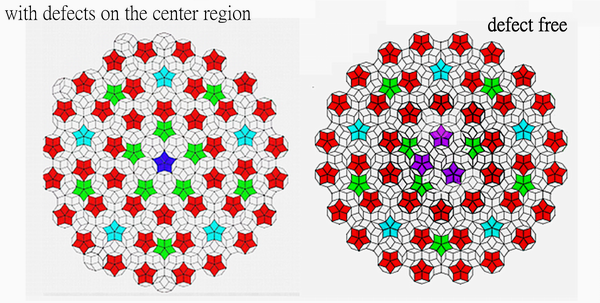
The extended hierarchy explains why a Penrose tiling can have no translational symmetry. but still can see partially slanted shift repeatability. 擴展層次結構解釋了為什麼彭羅斯平鋪沒有平移對稱性。, 但仍然可以看到部分傾斜的移位重複性。
There can be very few styles to make a-type, b-type, f-type forming the central core five-fold symmetric tiles and to be easily extended to an infinite non-repeatable Penrose tiling by intuition.
可以有非常少的樣式來製作 a 型、b 型、f 型形成中央核心五重對稱瓷磚,並且很容易憑直覺擴展為無限不可重複的彭羅斯瓷磚。
(A) type-a as center and souurounded couple by five type-b, (B) five type-b decagons mutully souurounded couple , (c) five type-f decagons mutully souurounded couple (g) five type-c decagons mutully souurounded couple ( this one is not a two fold dymmetry) 第一個 (A) type-a 為中心,由五個 b 型包圍,(B) 五個 b 型十邊形相互包圍,(c) 五個 f 型十邊形相互包圍,(g) 五個 type-c 十邊形
we may them in to two simple shapes at very beginning; circular shape and pentagon shape. 一開始我們可以將它們分成兩個簡單的形狀;圓形和正五邊形。all the tiles can be extended by corresponding rings couple stacked, 所有的瓷磚都可以通過相應的環對堆疊來擴展
all the Penrose-tiles can be extended by corresponding rings or edge tiles of pentagons to surrounding stacked couple and extend to infinite. 所有的彭羅斯瓦片都可以通過相應的環或五邊形的邊緣瓦片延伸到周圍的堆疊對並延伸到無限。 This can be easily demonstrated by a circular Penrose tile (containing two type-a and tyoe-b decagons) . Shown in Following: A large
a large Pentagon shape (circular shape) Penrose tile infact contains some smaller circular (pentagon) type Penrose tiles, (could be two different configurations with different center core styles) )
as shown in this figure, a larger size Pentagon penrose tile containing several smaller size Pentagon penrose tiles as well as containing several smaller size circular tiles. 如圖所示,一個較大尺寸的五角大樓彭羅斯瓷磚包含幾個較小尺寸的五角大樓彭羅斯瓷磚以及幾個較小尺寸的圓形彭羅斯瓷磚。
as shown in following, containing large area correctable defects, leave defect for reader to correct them.
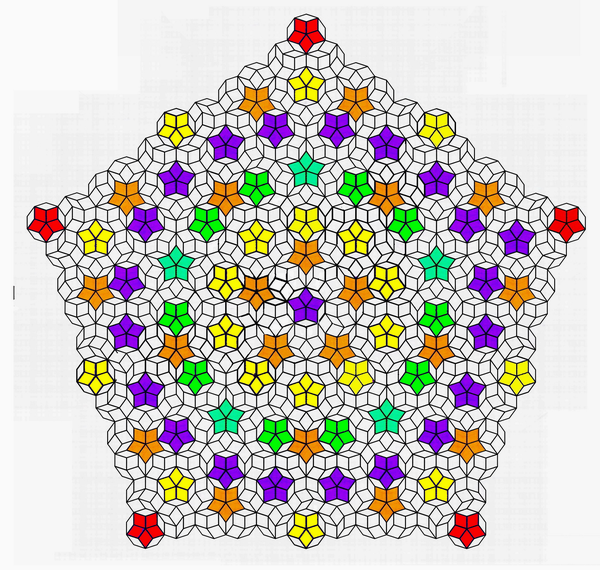
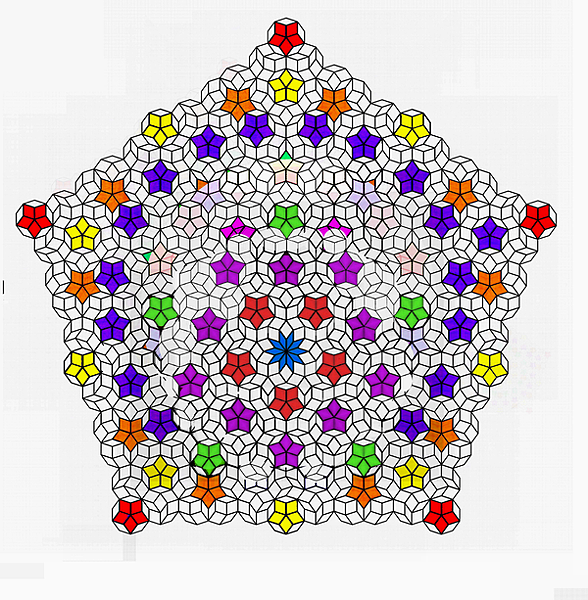
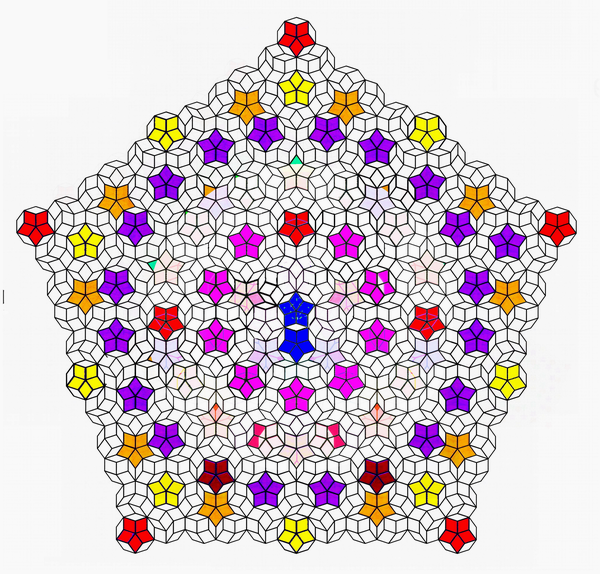
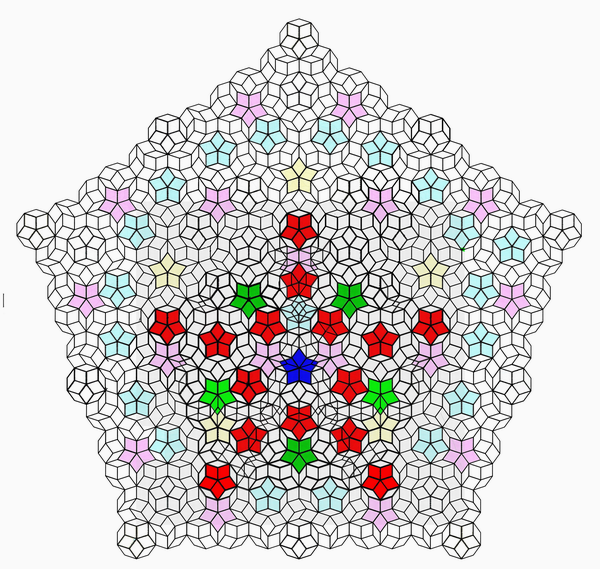
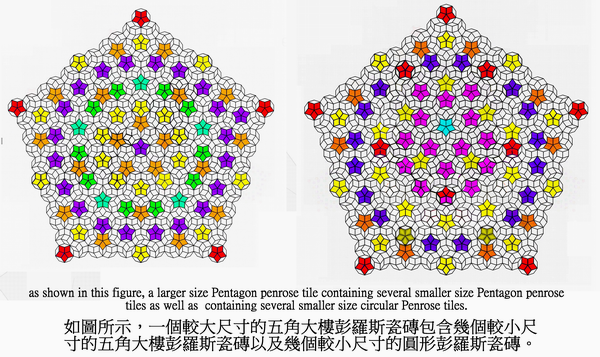
In above figs , left one has one defect, right ome defect free,../
(((Since the inflated tiling is unique, any translational symmetry of a tiling must be a symmetry of its inflated tiling, and therefore every tiling in the inflation hierarchy. However, if we move up far enough in the inflation hierarchy, the size of the tiles is eventually much larger than the length of the translation. It is therefore impossible for the translation to be a symmetry of that inflated tiling, and so the translation cannot be a symmetry of the original tiling.
A second fact implied by the inflation hierarchy is also curious. We noticed earlier that there were small patches of tiles that seemed to show up repeatedly in a tiling. In fact, any finite patch that we choose in a tiling will lie inside a single inflated tile if we continue moving far enough up in the inflation hierarchy. This means that anywhere that tile occurs at that level in the hierarchy, our original patch must also occur in the original tiling. Therefore, the patch will occur infinitely often in the original tiling and, in fact, in every other tiling as well. The figure above illustrates this fact.
Taken together, these two facts speak to the remarkable nature of Penrose tilings. There is never a translation that preserves the entire tiling, and so there is no fundamental unit that generates the tiling. Any finite patch, however, appears infinitely often in the tiling.
The inflation hierarchy can also help us construct tilings. Remember that if we place tiles using only the matching rules, we often create patches that cannot be extended. We may avoid this fate, however, if in addition to the matching rules, we also require that the rhombs in the patch we have constructed may be grouped so as to form an extensible inflated patch. Here is a Java program that allows you to add a tile only when the resulting patch is consistent with some extensible inflated patch.)))
References
General references on Penrose tilings and inflation
- N.G. de Bruijn, Updown generation of Penrose tilings, Indagationes Mathematicae, New Series 1(2), 1990, 201-19.
- M. Gardner, Extraordinary nonperiodic tiling that enriches the theory of tiles, Scientific American, January 1977, 110-121.
- B. Grünbaum and C.G. Shephard, Tilings and patterns, W.H. Freeman, New York, 1987.
- M. Senechal, Quasicrystals and geometry, Cambridge University Press, Cambridge, 1995.
- R. Penrose, Pentaplexity, Eureka 39, 1978, 16-22.
History and biography
- J.V. Field, Kepler's star polyhedra, Vistas Astronomy 23(2), 1979, 109-141.
- M. Senechal, The Mysterious Mr. Ammann, Mathematical Intelligencer 26, 2004, 10-21.
Quasicrystals
- R. Lifschitz, The rebirth of crystallography, Zeitschrift fur Kristallographie 217, 2002, 342-343.
- R. Lifschitz, Quasicrystals: A matter of definition, Foundations of Physics 33, 2003, 1703-1711.
- D. Schechtman et al, Metallic phase with long range orientational order and no translational symmetry, Physical Review Letters 53, 1984, 1951-1954.
Nonlocal properties of Penrose tilings
- R. Penrose, Tilings and quasicrystals: a nonlocal growth problem?, in Introduction to the Mathematics of Quasicrystals, edited by Marko Jaric, Academic Press, 1989, 53-80.
- J. Socolar, Growth rules for quasicrystals, in Quasicrystals: the state of the art, edited by D. DiVincenzo and P.J. Steinhardt, World Scientific Publishers, 213-38.
Penrose's patent
- S. Mirsky, The Emperor's New Toilet Paper, Scientific American, July 1997, 24.
- U.S. Patent and Trademark Office. To find Penrose's patent, search for patent 4,133,152.
Crystallography
Though Penrose tilings grew out of recreational mathematics, they were soon pressed into service to explain a new phenomenon in crystallography, the study of solids that are "ordered" at the microscopic level. Historically, it was assumed that this order was created by the periodic repetition of a fundamental unit. Indeed, the advent of X-ray diffraction seemed to confirm this assumption as all observations made over the course of 70 years were consistent with it. In particular, diffraction patterns with 5-fold rotational symmetry were never observed, a fact that was seen to validate the assumption that the order in crystals arose from a periodic internal structure.
In 1982, Schechtman and his associates rapidly cooled an aluminum-manganese sample and observed that the alloy produced a diffraction pattern with 5-fold rotational symmetry. Though this pattern could not be formed by a periodic crystal, the diffraction pattern itself clearly reflected some type of orderliness in the alloy.
退休幾年,花了許多時整理幾佰張圖片。其中最值得一提的就是很幸運重新闡釋了潘若斯鋪磚圖(Penrose tiling),並且製作了十幾種大同小異的正五角形潘若斯鋪磚圖案。用了三種不同的耦合方案,將圖案延伸到無限大。 羅傑潘洛斯(Roger Penrose)是2020年物理諾貝爾獎得主,在天文學上有突出的貢獻。他最著名的潘洛斯鋪磚圖是最複雜的鑲嵌圖案之一,畫出了特殊的五重性圖案,是可以無限大的延伸。.並且被大家以多種不同的方式繪製和表達,是一種很大眾化流行的數學圖案。其後,丹尼爾.夏契曼(Daniel Shechtman)1982年發現了準晶体,並且在得到2011年化學諾貝爾獎。
潘若斯1974年製作的圖案,有助於瞭解準晶體,並引發了該領域的許多有關研究。在這篇論文中,作者只是集中盡可能多地展示彭羅斯平舖的所有基本單位Present all basic unit for penrose tiling as much as I can . There are Two basic shapes of Penrose tiling: pentagon shape and circular shape,
Fig 1 The most popular original Penrose tiling, containing only two decagons type-a and type-b, it looks like Pentagon shape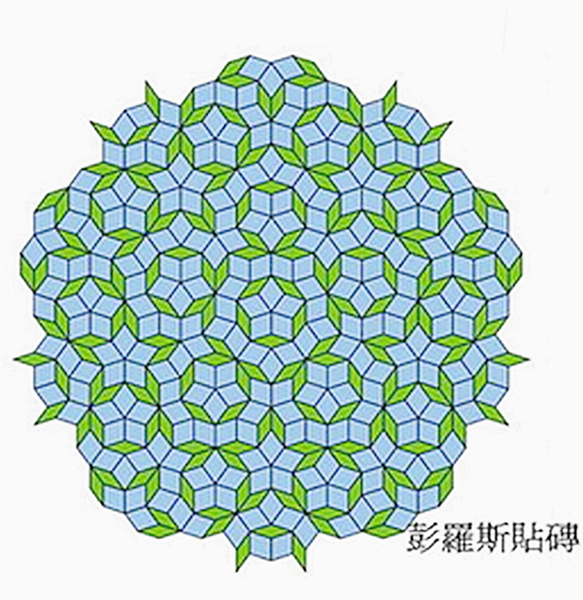
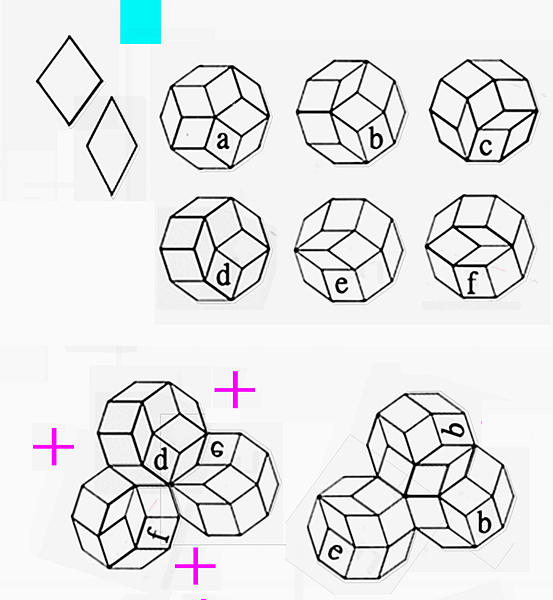
all vertexs are type-a decagon, three decagons each side, two different types left one all five vertexs type-a decagons down, right ones all five vertexstype-a decagons up
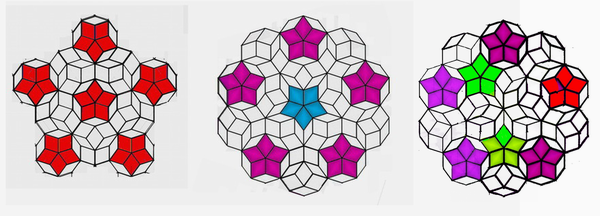
slim pentagon shape, only two types of decagon involve into the configuration, five vertexs may be all replaced by suitable decagons, type-d,-e-,-f., 只有兩種類型的十邊形涉及配置,五個頂點可以全部替換為合適的十邊形,類型-d,-e-,-f。,and again in the circular shape, type-a decagon may be replaced by suitable decagons type-d,-e-,-f.,
This one revealing a pentagon shape ,is the modified typic penrose tiling containing only two types decagons, five vertexs could be replaced by any one of the six decagons
這個是五邊形的,是修改後的典型彭羅斯拼貼,包含兩種十邊形,五個頂點可以用六個十邊形中的任何一個代替,

.
Blue stars .
,blue stars surround out forming a pentagon shape with four decagons on each side, is a smaller standard Penrose tiling, red stars surround out forming an even smaller pentagon shape with three decagons on each side, containing only type-a and type -b decagons;藍色的星星圍繞著形成一個五邊形,每邊有四個十邊形,一個較小的標準彭羅斯瓷磚,只包含 a 型和 b 型十邊形;紅色的星星圍繞著形成一個更小的五邊形,每邊有三個十邊形,只包含 a 型和 b 型十邊形
This following circluar shape Penrose tiling may have two different types of center, contains only two types of decagons.
This following smaller one , is an asymmetric circular type Penrose tiling containing only two decagons,the center one could be type-b ,-c decagon.tiling can be extended to infinite by adding rings (with inner defects)
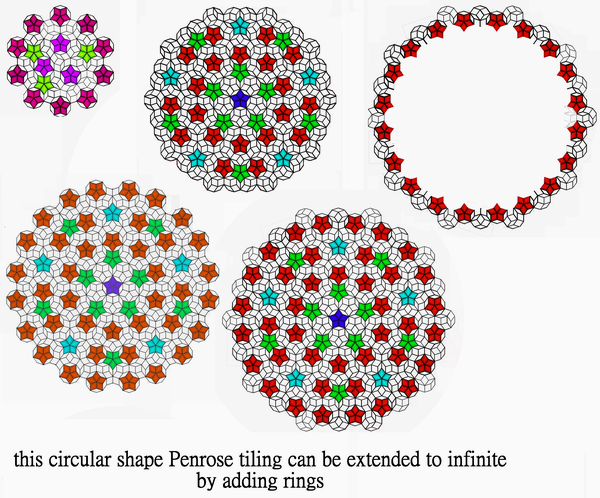

這個這是一個不對稱的圓形彭羅斯瓷磚,包含兩個十邊形,中間一個可以是類型 -b、-c 十邊形。這個這是一個不對稱的圓形彭羅斯瓷磚,只包含兩個十邊形,中心一個可以是 b 型,-c 十邊形。該圖顯示了圓形彭
Using symmetric circular Penrose tiling might be much easy to demonstrate the successful of coupling (but not defect free doe this circular )/使用對稱圓形 Penrose 平鋪可能更容易證明耦合成功
羅斯平舖的耦合深度。作者打算留下可修正的缺陷區域(接縫區域),讀者可以看到它是多麼容易用正確的十邊形修復。The author intends to leave the defect area (seam area) correctable, the reader can see how easy it is to repair with the correct decagon
This figure showing how deep the coupling of the circular penrose-tiling might go. Author intended to leave the correctable defect areas, readers may see how easy to fix it with the correct one.
some one might be noticed that some new type of decagons have to be generated to meet defect free requirement.該圖顯示了圓形彭羅斯平舖的耦合深度。有些人可能會注意到,必須生成一些新型的十邊形才能滿足無缺陷要求。
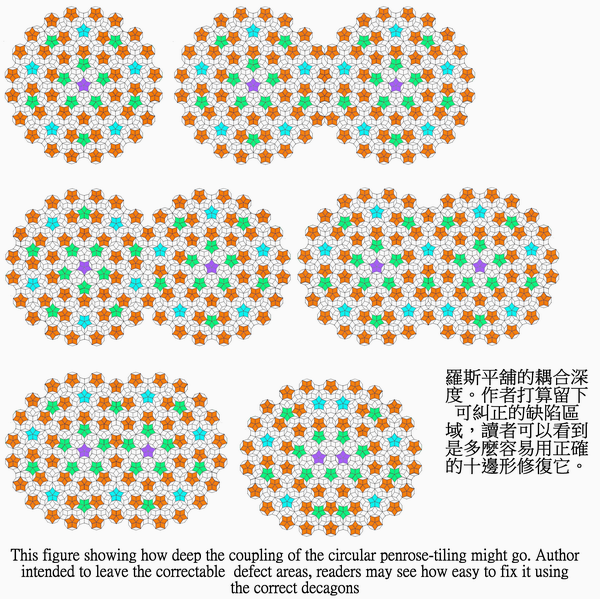

this figure showing a slanted shift coupling for circular Penrose tiling, again , leave some (NOT EASY) correctable defects for readers..THESE Self coupling all generated inner defects
此圖顯示了圓形彭羅斯拼貼的傾斜移位耦合,為讀者留下一些可糾正的缺陷
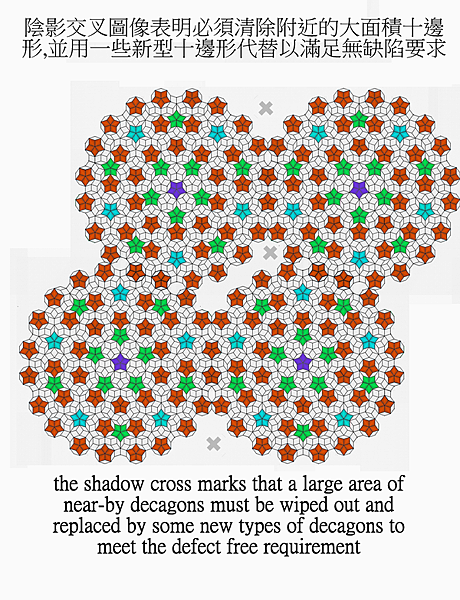
the shadow cross marks a large area of near decagons nust be wiped out and replaced by some new types of decagons to meet the defect free requirement
陰影交叉圖像表明必須清除附近的大面積十邊形,並用一些新型十邊形代替以滿足無缺陷要求
This above fig, showing how to couple circular penrose-tiling to form larger ones.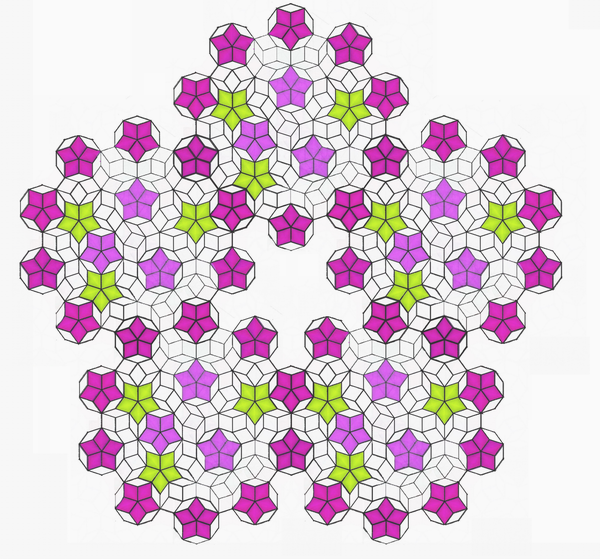 This above fig, showing how to couple circular penrose-tiling to form larger ones上圖顯示如何將圓形彭羅斯平鋪耦合以形成更大的彭羅斯平鋪。
This above fig, showing how to couple circular penrose-tiling to form larger ones上圖顯示如何將圓形彭羅斯平鋪耦合以形成更大的彭羅斯平鋪。



 留言列表
留言列表


